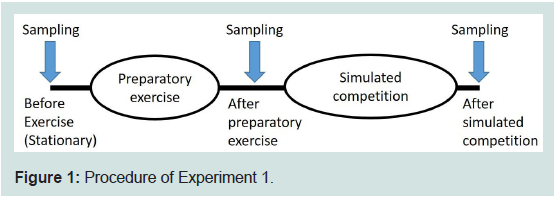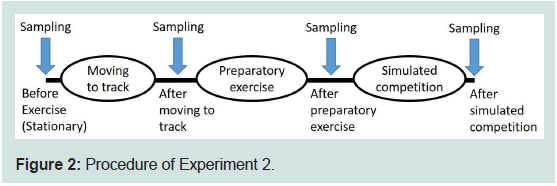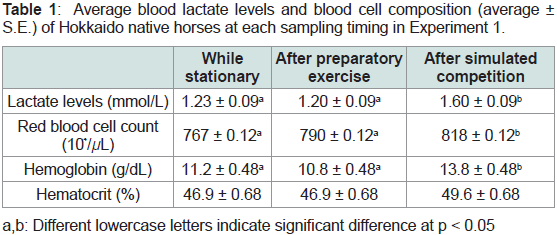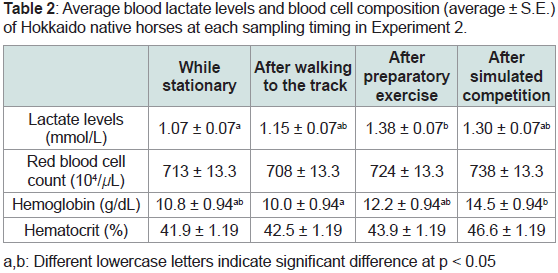Journal of Veterinary Science & Medicine
Download PDF
Research Article
Changes in Lactate Levels and Blood Cell Composition in Hokkaido Native Horses after exercise Simulating Yabusame (Traditional Japanese Mounted Archery)
Saitoh T, Okamoto Y and Acosta TJ*
Field Center of Animal Science and Agriculture, Obihiro University
of Agriculture and Veterinary Medicine, Inada-cho, Obihiro,
Hokkaido - 080-8555, Japan
*Address for correspondence:
Acosta TJ, Field Center of Animal Science and Agriculture, Obihiro
University of Agriculture and Veterinary Medicine, Inada-cho, Obihiro,
Hokkaido - 080-8555, Japan; E-mail: tjacosta@obihiro.ac.jp
Submission: 23 March, 2022
Accepted: 15 April, 2022
Published: 19 April, 2022
Copyright: © 2022 Saitoh T, et al. This is an open access article
distributed under the Creative Commons Attribution License, which
permits unrestricted use, distribution, and reproduction in any medium,
provided the original work is properly cited.
Abstract
The history of Yabusame (traditional Japanese mounted archery)
as a modern sport is short, and only a few physiological studies
have been conducted on the horses used. Therefore, this study
investigates changes in blood cell composition and lactate levels
of Hokkaido native horses used for Yabusame to determine whether
the current exercise regimens are appropriate. We conducted the
same experiment at two Yabusame horseback riding facilities, each
using four horses of the Hokkaido native breed. In Experiment 1,
blood samples were taken at three time points (while stationary, after
preparatory exercise, and after horses had cantered five times on a
170 m track to simulate the Yabusame competition). In Experiment 2,
blood samples were taken at four time points (while stationary, after
walking for ~10 min to the racetrack, after preparatory exercise, and
after cantering five times on a 150 m track to simulate competition).
Lactate Pro and a blood cell counter were used to measure lactate
levels and blood cell components, respectively. In Experiment 1,
lactate concentration, red blood cell count, and hemoglobin were
significantly (p<0.05) higher after exercise than the baseline. In
Experiment 2, both lactate concentration and hemoglobin levels
rose significantly (p <0.05) from stationary levels after walking to the
track and performing the preparatory exercise. However, lactate
concentration remained within the physiological range (<4 mmol/L,
a threshold that indicates fatigue in horses) even after the elevated
physical activity. Therefore, the exercise tested in this study did not
impose an excessive physiological burden on the horses.
Keywords
Japanese mounted archery; Hokkaido native horses;
Lactate concentration; Blood components; Equine physiology
Introduction
Yabusame (traditional Japanese mounted archery) originated
about 1,000 years ago as a sport designed to improve shooting arrows
from a galloping horse, a dominant form of ancient warfare [1]. In
modern Japan, Yabusame is primarily a Shinto ritual, with different
regional forms passed down from generation to generation. At
shrines, Yabusame involves multiple ceremonies, often with strict
rules of etiquette and restrictions on participation. This visibility,
coupled with an increasing interest in historical traditions, has
spurred a movement to enjoy such mounted archery safely as a sport.
Thus, the Japan Yabusame Federation was established in the Tokachi
area of Hokkaido in 2002. Over the past 20 years, the organization
formulated rules and regulations for Yabusame while promoting the
sport. As the number of enthusiasts and world-class competitions
increased, Yabusame developed into a major tourist attraction that is
expected to economically benefit the region [2].
Yabusame involves shooting arrows at multiple targets while riding a galloping horse along a set racecourse, with total points
tallied at the end. Horses must be of Japanese breed, although any
size is acceptable. The competition field is approximately 180-200 m
long and 2.5-3 m wide, with targets spaced 50-60 m apart while being
3-4 m away from the archer [2]. In addition to having formalized
competitive structure, clear regulations have also been put in place
regarding human equipment (e.g., helmets, protectors, type of bow)
and horse equipment (e.g., saddle type). However, no rules have been
set on the number of times a horse can run, although past organizers
have indicated that they typically run four to six times.
The horse usually used for Yabusame in Hokkaido is a
native Japanese breed originating in Hokkaido. They are small at
approximately 125-135 cm in height and 350-400 kg in weight. Owing
to their low sway at trot and mild nature [3,4], these Hokkaido horses
are also a common choice for less experienced riders, outdoor riding
such as trekking, and horse therapy. However, in 2022, the number
of registered horses dropped to 1,083 [5], a 64% decrease compared
to the year 2000, indicating a need to protect this native breed. In
particular, given their popularity in Yabusame, more data is required
to understand their physical limits. This would provide a scientific
basis for rules regarding the number of times the horse should run
during competitions. Therefore, this study was conducted to simulate
the physical efforts of horses during the actual Yabusame competition.
Furthermore, changes in lactate, red blood cell count, hemoglobin,
and hematocrit levels were measured to evaluate whether the
number of runs is appropriate and does not place excessive burden
on the horses. This is the first study to measure these physiological
parameters in Hokkaido native horse breeds during exercise.
Materials & Methods
All protocols were approved by the Ethics Committee on the
Use of Animals from the Obihiro University of Agriculture and
Veterinary Medicine (approval number 21-138). Two sets of the same
experiments (Experiments 1 and 2) were conducted at two locations.
Experiment site and date:
Experiment 1 was conducted on October 13, 2021, at a mounted
archery competition track (approximately 170m) in a Hokkaido native horse breeding ranch located in Memuro (Hokkaido
prefecture, Japan). Experiment 2 was conducted on October 14, 2021,
at another mounted archery competition track (approximately 150m)
in a riding club in Memuro.Test animals and riders:
Experiment 1 used four Hokkaido native horses, two geldings and
two mares aged 2-14 years old. Experiment 2 also used four Hokkaido
native horses, three geldings and one mare aged 4-17 years old. All
eight horses previously participated in Yabusame competitions and
were well acclimated to the tracks used in the experiments.All participating riders (three women and two men) had between
5-25 years of riding experience, with sufficient riding skills for the
simulated competition runs conducted in the experiments.
Experimental procedures:
Experiment 1 was performed twice with two horses each (Figure 1). Initial blood samples were taken immediately after horses were
saddled. Thereafter, horses were ridden to the competition track,
where the rider performed a preparatory exercise involving one walk
followed by one trot around the track before a second blood sample
was taken. Participants then performed a simulated competition
run involving five canters (approximately 400 m/min) before a third
blood sample was obtained.In Experiment 2, all horses were tested simultaneously (Figure 2).
Again, the first blood sample was taken immediately after saddling.
Horses were walked to the competition track (approximately a
10-minute journey), where a second blood sample was taken. Riders
then performed the same preparatory exercise as in Experiment 1,
and a third blood sample collection followed. Finally, participants
engaged in the simulated competition run (see Experiment 1) before
a fourth blood sample was obtained.
Blood sampling and analysis:
Blood was sampled from the jugular vein of stationary horses
without riders, then placed either in tubes containing 5 mL sodium
heparin (sterile Benoject vacuum blood collection tubes, Terumo
Corporation, Tokyo, Japan) for measuring blood lactate or in tubes
containing 5m LEDTA 2Na for measuring blood cell components
(sterile Benoject vacuum blood collection tubes, Terumo Corporation, Tokyo, Japan). Thereafter, tubes were quickly chilled in ice and
transferred to the laboratory about 2 hours.Blood lactate levels were measured immediately after samples
were brought back to the laboratory using Lactate Pro™2 (Arkray Inc.,
Kyoto, Japan). Variables related to blood cell components (red blood
cell count, hemoglobin volume, and hematocrit value) were measured
the next day between 10:00 and 12:00 with a fully automatic blood
cell counter (MEK 6550 Seltac α, Nihon Kohden Corporation, Tokyo,
Japan). The lactate levels and blood components were compared
before and after the exercise to assess the physiological level of the
horses’ effort.
Statistical analysis:
Blood lactate, red blood cell count, hemoglobin, and hematocrit
data of four horses per experiment were averaged and then compared
between the different blood sampling timing (before and after the
simulated competition) using Tukey’s multiple comparisons. Data
from Experiments 1 and 2 were analyzed separately. All analyses were
performed in R (version 4.1.1) software. Significance was set at p <
0.05.Results
Experiment 1:
The blood lactate of four horses was significantly (p<0.05)
higher after simulated competition than the stationary time point
and after the preparatory exercise (Table 1). Red blood cell count
and hemoglobin levels were also significantly (p<0.05) higher
after simulated competition than the stationary stage and after the
preparatory exercise. However, average hematocrit values did not
differ significantly pre- and post-exercise (simulated competition).
Table 1: Average blood lactate levels and blood cell composition (average ±
S.E.) of Hokkaido native horses at each sampling timing in Experiment 1.
Experiment 2:
Blood lactate values were significantly (p<0.05) higher after
walking to the track than before the preparatory exercise (Table 2). Blood red blood cell count and hematocrit values did not differ across the sampling time points. Hemoglobin levels were significantly
(p<0.05) higher after the preparatory exercise than the stationary
stage.Discussion
Piccone et al. reported that the resting levels of blood lactate
ranged from 0.65 ± 0.07 to 4.24 ± 0.72 mmol/L for horses of
various utility, breeds, and sexes [4]. Pre-exercise lactate levels
of horses in our study were all within this range. Thus, the horses
used in the present study were in normal physiological condition
and not fatigued before the experiment. Furthermore, Piccone et
al. also reported that show jumpers exhibit a significant increase
in blood lactate levels after participating in a 350 m course with
eight obstacles (5.07 ± 2.14mmol/L from 2.26 ± 1.18mmol/L preexercise)
[5]. In Experiment 1, we also found that lactate increased
significantly post-exercise (1.60±0.09mmol/L) compared with preexercise
(1.20±0.09mmol/L). However, the rate of increase was not as
great as seen in the previous study [6], indicating that the simulated
competition was not a significant burden for the horses. In addition,
one of the commonly used indicators of exercise intensity is “onset of
blood lactate accumulation (OBLA)”, a blood lactate concentration
of approximately 4 mmol/L [7]. Reaching this threshold suggests
the beginning of fatigue in horses. In this study, none of the horses
exceeded the onset value, indicating that they were not fatigued
during the simulated competition.
Red blood cell count, hematocrit, and hemoglobin measurements
are associated with the ability to transport oxygen to cells. In this
study, values for all three variables-even after exercise-were close to
previously reported averages of the Noma horse, another Japanese
breed [8]. In contrast to an earlier study that identifies differences in
blood composition between horses trained for sport versus recreation
[9], this study did not observe such variation. This outcome also
suggests that the horses were not overworked during our simulated
competitions. Indeed, subject horses appeared to be well trained for
Yabusame competitions; therefore, we conclude that the current
standard for the number of runs (4-6 times) is reasonable for
participating horses.
In considering the animals’ welfare, this study did not examine
the blood parameters of the horses in fatigue conditions. This issue
is important because of the rising interest in the welfare of horses
during equestrian events. In conclusion, the exercise tested in this
study (simulated competition run) did not impose an excessive
physiological burden on the horses, and we also clarified for the first
time the physiological changes that occur while Hokkaido native
horses engage in exercise-simulating mounted archery competitions.
Acknowledgment
We would like to thank the riders and owner (Mr. Hiroyuki
Kawahara) of horses used for Experiment 1 and also thanks to Ms.
Mihoko Nakamura for her assistance with Experiment 2.





